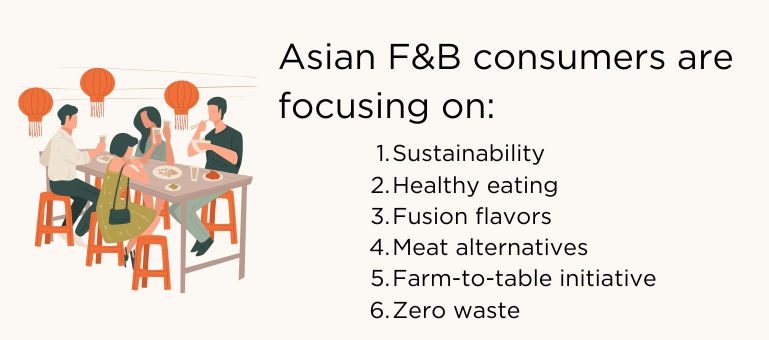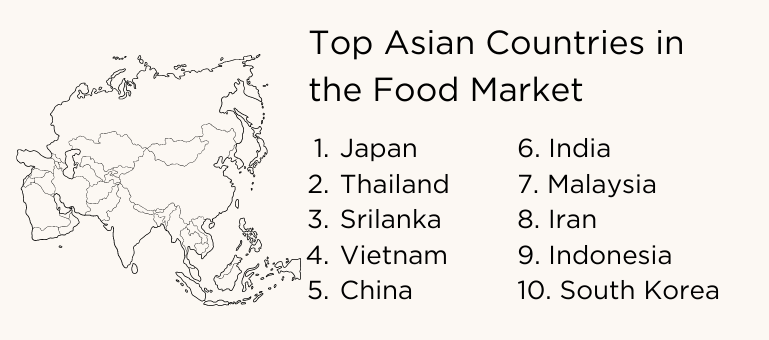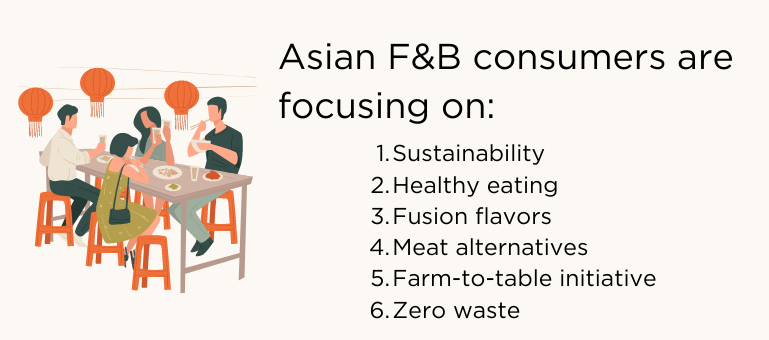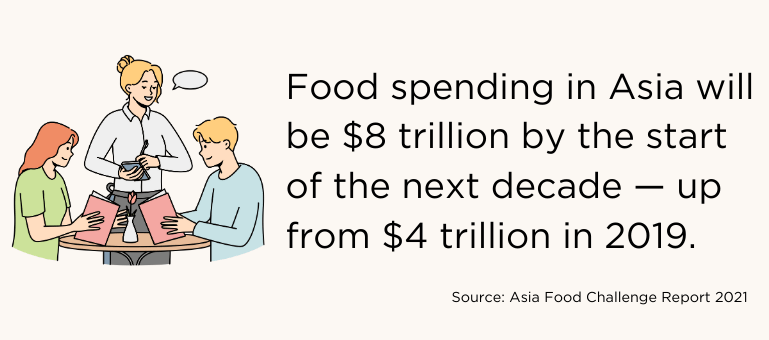Asia’s food and beverage (F&B) industry is a strong player in the global food sector. This region holds a significant portion of the global food market, making it an attractive destination for F&B businesses.
When it comes to size, the Asian F&B market is truly remarkable, with countries like China and India accelerating their growth. This market is characterized by both quantity and quality, showcasing a mix of local spots and international food chains.
One of the most exciting aspects is that the culinary experience in Asia is never-ending. F&B statistics in Asia highlight an ever-evolving industry, with emerging trends and innovative ideas continually changing the F&B landscape.
For businesses considering entering this region, gaining insights into the current stats of the F & B industry in Asia is the key to unlocking a world of possibilities.
So, whether you’re a passionate food enthusiast or an entrepreneur, get ready to explore new opportunities in the F&B sector in Asia.
Overview of Asia’s Food and Beverage Market
If you want to open your restaurant or offer food and beverage services in the Asian F&B market, you need to get an overview of the industry and key players. So let’s explore all the important aspects and statistics related to the Asian food and beverage market.
Current State of F&B Industry in Asia
With its expansive size and diverse array of offerings, it’s no wonder that the Asian F&B industry plays a significant role in the global food setup. This market caters to millions of taste preferences and cultures.
In the year 2022, the total revenue in the Food & Drink market in Asia reached a substantial US$1 billion. This market is anticipated to witness strong growth, with an annual growth rate (CAGR 2022-2027) of 10.91%. By the year 2027, the projected market volume is expected to reach US$2 billion.
Numerous revenue sources contribute to the market’s expansion. In-app purchases (IAP) accounted for US$235.80 million in 2022, and paid app revenue reached US$59.11 million. These figures highlight a promising landscape of the F&B industry in Asia.

The Food & Drink market is also experiencing a surge in food app downloads, with a projected 1.80 billion downloads in 2022. The average revenue per download is currently estimated to be US$0.52.
A global comparison reveals that most of the Asian F&B revenue is generated in China, which was US$850.40 million in 2022.

With such promising growth projections and revenue figures, Asia’s Food & Drink market is proving to be an exciting and dynamic landscape for businesses and consumers.
The market segments are also versatile, catering to the taste of various cultures. The market segment comprises traditional delicacies, modern fusion delights, health-conscious options, and treats that satisfy every craving. This variety is what makes Asia’s F&B industry a food hub.
The F&B market in Asia constantly evolves, with new trends and innovations on the horizon. So, whether you’re a food enthusiast or a business enthusiast, understanding the current state of the F&B industry in Asia is the ideal approach to succeed!
Market Share and Trends in Asian F&B Sector
As a business, understanding the market share of different food and beverage segments in Asia is essential for making strategic decisions.
The F&B market in Asia is a dynamic landscape, constantly evolving to meet the ever-changing preferences of consumers.
According to the Food And Beverages Global Market Report 2023, the global F&B market is expected to grow to $8,905.5 billion in 2026 at a compound annual growth rate (CAGR) of 8.7%.
Asia Pacific was the largest region in the food and beverages market in 2021, indicating the Asian F&B sector channels the majority of this growth.

Source: Asian Food Market Research
Asian F&B emerging trends play a crucial role in shaping the F&B market, and being aware of these trends can give your business a competitive edge.
Whether it’s the rising popularity of plant-based diets, the demand for functional foods, or the fusion of diverse culinary influences, staying updated on these trends will help you meet the needs of your target audience.
Consumer preferences in the Asian F&B sector are diverse. From traditional local delicacies to international cuisine, understanding what consumers want is vital for creating successful marketing strategies.
F&B Statistics and Growth Projections for 2023
This section will dive into the numbers and insights shaping Asia’s food and beverage industry, highlighting the trends and opportunities ahead. Let’s uncover the data that will drive strategic decision-making from market size to emerging trends.
So, let’s explore interesting F&B statistics and growth projections!
Regional Outlook for Asia’s Food Market
Understanding the regional outlook for Asia’s food market is crucial for strategic planning and decision-making. Each region offers unique growth prospects, challenges, and openings. Being well-informed about these factors can give your business a competitive edge.

Analyzing market trends and consumer behavior will give you valuable insights into which regions are perfect for expansion. Here are some of the prominent stats reflecting the outlook for the Asian Food Market.
Leverage Sector Analysis and Future Forecasts
The future forecast for the F&B industry in Asia is very promising. As the world understands the charm of Asia and appreciates the opportunities available here, the CAGR of the Asian F&B sector is expected to grow.
Considering the current and future trends can help you decide the layout of your business and improve your future planning.

For instance, considering the focus on healthy diet options, mixing cuisines, and being mindful of dietary restrictions can help you create a menu that caters to all and ultimately plays a crucial role in the success of your business.
Some of the insights that can really help you include the following:
- Asian Alternative Protein Market
- Asia’s Coffee Market Trends
- Innovation in Sustainable Food Packaging
Additionally, focusing on future industry prediction can help you make an informed decision, so it is crucial to research all aspects related to business ventures for risk assessment.
Key Drivers and Challenges for Asia’s F&B Industry
By understanding and leveraging these growth drivers, businesses in Asia’s food and beverage market can position themselves for success.
Adapting to changing consumer preferences, embracing technology, fostering culinary innovation, and utilizing online markets are key strategies to drive growth and thrive in this competitive industry.
Growth Drivers for Asia’s F&B Market
Consumer preferences are constantly evolving, and Asia’s F&B industry is quick to adapt. As consumers become more health-conscious and environmentally aware, there is a growing demand for nutritious, sustainable, and ethically sourced food options.

Embracing these changing preferences and offering innovative choices is a key driver for industry growth.
1. Urbanization
Rapid urbanization in Asia is reshaping the F&B market. With more people living in urban areas, there is an increased demand for convenient and on-the-go food options.
Quick-service restaurants, food delivery services, and ready-to-eat meals cater to the needs of urban consumers, driving growth in the industry.
2. Technological Advancements
Technology is revolutionizing the F&B sector in Asia. From AI-powered kitchen innovations to food delivery apps, technology is enhancing efficiency, convenience, and customer experience.
Utilizing these advancements in food technology is essential for businesses to stay competitive and meet the expectations of tech-savvy consumers.
3. Culinary Fusion and Innovation
Asia’s rich culinary heritage and cultural diversity inspire culinary fusion and innovation. Chefs and food entrepreneurs constantly experiment with unique flavors, fuse different cuisines, and create memorable dining experiences.
This creativity and innovation attract food enthusiasts and contribute to the industry’s growth.
4. Rise of E-commerce and Online Platforms
The rise of e-commerce and online food platforms has opened up new avenues for F&B businesses to reach a wider audience. These platforms help restaurants and food brands to expand their customer base and increase sales, driving growth in the market.
By identifying and harnessing these growth drivers, Asia’s food and beverage industry is ready for a successful future.
Understanding the factors influencing industry growth empowers businesses to make strategic decisions that will shape the culinary landscape and cater to the preferences of consumers.
The fusion of consumer behavior insights, technological advancements, and culinary innovation can help you succeed in the F&B market of Asia.
Challenges and Opportunities in F&B Sector
As we explore Asia’s food and beverage sector, we must understand the challenges and exciting opportunities for industry players in 2023.
Challenges:
As a new stakeholder in the F&B sector in Asia, here are some of the challenges you can face.
| Changing Consumer Preferences | As tastes evolve, staying relevant and meeting diverse demands becomes crucial for sustained success. |
|---|---|
| Competition | Standing out and differentiating in such a crowded market requires innovation and a unique value proposition. |
| Supply Chain Disruptions | Ensuring a resilient and responsive supply chain is paramount to prevent supply chain disruption. |
| Regulatory Environment | Compliance with food safety standards and local laws is essential but challenging. |
Opportunities:
Here are some of the opportunities in the Asian F&B sector you can explore to penetrate this exciting market.
| Technology Adoption | Embracing technology and digital solutions offers opportunities for enhanced efficiency, better customer engagement, and data-driven insights to understand consumer behavior. |
|---|---|
| Health and Wellness Focus | With the rising demand for health-conscious options, businesses can capitalize on the wellness trend by offering nutritious and functional foods that cater to health-conscious consumers. |
| Sustainability Initiatives | Incorporating sustainable practices can be a competitive advantage. Environmentally friendly sourcing, reduced food waste, upcycled food, and eco-friendly packaging resonate with socially conscious consumers. |
| Cross-Border Expansion | Exploring opportunities beyond domestic borders opens new markets and audiences. International expansion can be a growth catalyst for F&B businesses. |
| Innovation and Collaboration | Staying at the forefront of culinary trends and forging collaborations with other industry players foster creativity and attract new customers. |
Navigating the F&B landscape in Asia requires a strategic approach that addresses challenges while seizing opportunities.
By understanding consumer preferences, embracing innovation, and adopting sustainable practices, businesses can position themselves for success in this ever-evolving market.
Overcoming challenges and capitalizing on opportunities will help industry players to thrive and create a promising future for Asia’s food and beverage sector.
Conclusion
The F&B industry in Asia is a powerful player with a significant global market share. Countries like China, India, Japan, and South Korea are leading the way, creating a diverse blend of flavors and innovations in the region.
To succeed in this dynamic culinary landscape, businesses need to understand the F&B statistics in Asia and the insights for 2023. These valuable trends can guide smart decision-making, helping businesses innovate, connect with consumers, and thrive in the Asian F&B market.
By staying informed about emerging trends and using insights effectively, businesses can enjoy success in this flavorful industry and make their presence known in the F&B sector in Asia.













